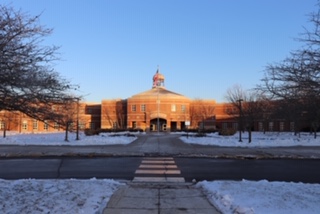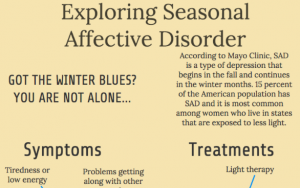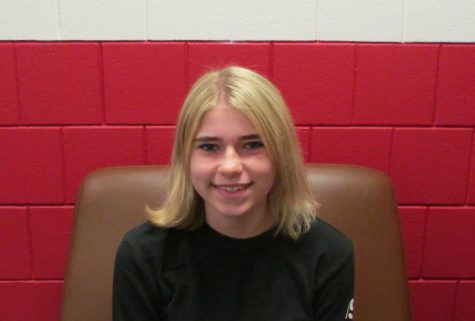Teachers and staff help those effected by Seasonal Affective Disorder

Many doctors recommend that people with SAD get outside in the mornings. There are four student centers where counselors are available.
February 16, 2019
Grades dropping, rare socialization and zero concentration. Already diagnosed with depression, junior Grace Murphy notices that things get a lot worse around winter time.
“My teachers are really great and understanding,” Murphy said. “One time when I missed five days of school leading up to break because I just wasn’t that great, my teachers gave me extensions and helped me out until I got my work back.”
Seasonal Affective Disorder (SAD) is estimated to affect over 10 million Americans and is recognized as a mental health disorder. SAD appears and disappears at around the same time each year, and usually have symptoms of depression as daylight hours become shorter. Many students are self-diagnosed, considering 95 percent of people who have SAD do not get treated.
Staff at Stillwater Area High School can help students with SAD and other mental disorders.
“One of the ways Seasonal Affective Disorder is treated is through light therapy,” Psychology teacher Roger Stippel said. “A simple step schools could do is lighting the classrooms that we have very well because the bulbs that we have now are not doing a lot to create a similar to light, as the sun would do.”
During light therapy, individuals sit near a light therapy box, which gives off a bright light that mimics natural outdoor light. By changing the bulbs in the school, fewer students with SAD or depression will feel tired during the day from the dim lights.
Schools as a whole, are overwhelmed by the number of students with cases of anxiety and depression.
“Schools could certainly get more counseling and more assistance, I think greater awareness and education on Seasonal Affective Disorder can benefit students,” Stippel said. “Acknowledging that this disorder really exists, and there are things schools can do, are the biggest things schools could probably do.”
Having school counselors who have the knowledge surrounding depression and SAD. Most of the school guidance counselors have a busy schedule and many responsibilities each day, which deters people with mental illness from going to their office. By having more counselors in our school who specialize in anxiety and depression, more students will be able to get help quickly and make a plan.
There are some relatively low-cost ways to treat SAD for students who do not feel comfortable talking to teachers and staff members.
“This is more in the psychiatric field,” Stippel said. “I don’t know that the commitment to the kind of resources needed to help cases like this specific psychological disorder are ever going to be in public schools, which is why more awareness on this issue could help students find treatments that work best for their situation.”
Intensive light box therapy, exercising and dietary changes are all ways to keep a happy mindset when daylight becomes shorter. Sticking to well-being therapies and trying to do things that make you happy is one of the best ways to try and combat SAD.
“Depression is different for everybody,” senior Mia Pariseau said. “Try to not shut down even when that’s all you want to do. Make sure you stay in contact with people and devise a certain schedule to get things done. Everything is so difficult, set an alarm and try to get one productive thing done. Even if it’s as small as taking a shower.”
Support increases students well-being and coping skills when dealing with mental disorders.
“Having a support network and teachers who you can vent to, and know how to push you to do work when you are having a bad day can help,” Pariseau said. “Your friends, of course, will always help if they have a good network. You just have to be open with people about what’s going on and try to trust them.”
Social support can reduce depression and anxiety because giving and receiving support is a basic human need. Psychologists often talk about the importance of having a strong social support network, because it helps people cope with stress, encourages healthy behaviors and improves motivation.
It is important to treat SAD because it can worsen pre-existing depression symptoms, and limits the ability to enjoy daily life. Keeping yourself busy by making plans, taking proper medications and scheduling therapies help reduce symptoms of SAD.
“You can definitely get through it,” Pariseau said. “You will see grass again, the sun will come out at some point and things will get a little better.”










